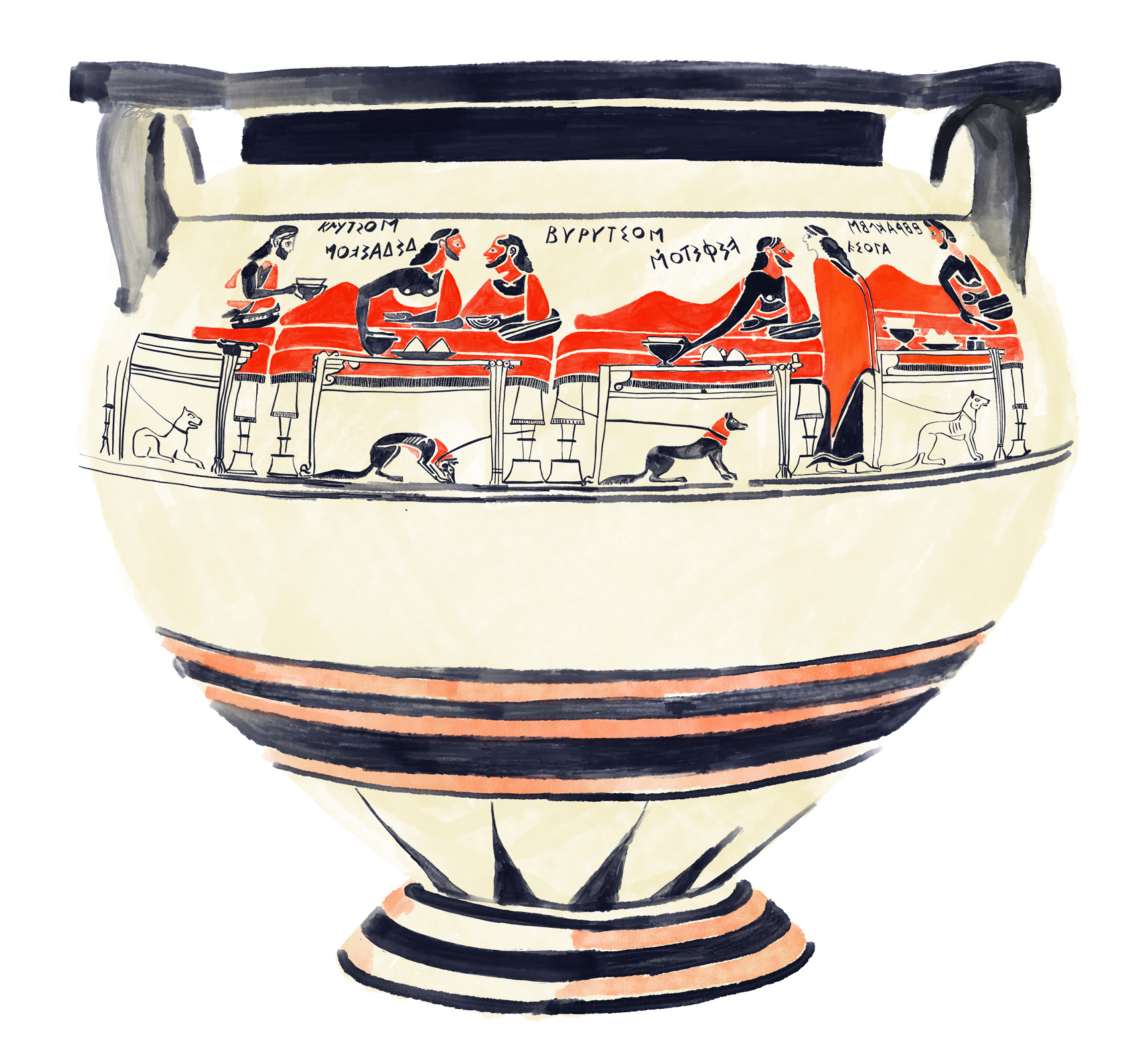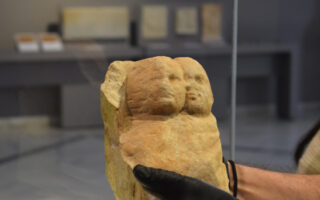By our side, in life and in death

The oldest archaeological evidence of domesticated dog bones comprises two significant discoveries: one in Germany, dating back 14,700 years, where a dog was buried alongside a couple; and another in Israel, dating back 12,000 years, where a woman was buried with a puppy nestled under her arm, only a few months old.
In Greece, depictions of dogs can be traced back to prehistoric times, predominantly appearing in Creto-Mycenaean art and exclusively within hunting scenes. However, it wasn’t until the Archaic period, starting from the 7th century BC onward, that the portrayal of domesticated dogs is witnessed. These representations mark a notable change in human perceptions of dogs, elevating them from mere objects of utility to esteemed companions in human life. Following this transformation, depictions of dogs in ancient Greek art proliferate, establishing them as the second most frequently depicted animals after horses.
As I peruse Panos Valavanis’ upcoming book, “Dogs from Ancient Times,” set to be published by Proti Yli publications, featuring exquisite illustrations by Chara Marantidou, I am deeply moved. This sentiment is not solely attributed to the content of the book, which offers a wealth of information detailing the historical companionship between dogs and humanity across various facets of life – from leisurely walks to symposiums, gymnasiums, wars, sanctuaries, and even literature. It’s also a testament to the profound dedication of a distinguished archaeologist and university professor who meticulously delves into the sources to bestow upon us invaluable insights. Moreover, the fact that this endeavor was inspired by a former stray dog, Paco, who found his way into the Valavanis family and transformed their lives, adds an extra layer to the narrative.
What inspired you to write a book about dogs?
Not just any dogs, but ancient dogs in particular. Because this is an opportunity to delve into the history of our cherished four-legged companions from their earliest days. How they were domesticated, how various cultures interacted with them, and how they evolved alongside humans. The bulk of the book focuses on their portrayal in the history and iconography of ancient Greece, where much of our information originates. Personally, I found the depictions of animals endowed with human speech and storytelling particularly captivating. It allowed me to put myself in their place and speak on their behalf. This role reversal intrigued me because it transcended the typical scientific discourse on the subject.
Who did you envision as your primary audience while writing the book?
Primarily children, although I’ve noticed from my other related works that readers of all ages are drawn to them. The key is to craft a book that captivates its audience, regardless of age, keeping them engrossed and eagerly anticipating what comes next. I believe that the book, with its engaging layout and Chara Marantidou’s imaginative illustrations, accomplishes this goal. Its aim is not only to impart knowledge in an entertaining manner but also to shape perceptions – in this case, fostering affection for animals.
Could you share three intriguing discoveries you made while researching for your book?
One revelation that left a lasting impression on me was learning about the origins and earliest traces of animal domestication. It was a revelation that both surprised and delighted me. Additionally, I was captivated by the ancient practice of categorizing breeds based on their unique traits and virtues. The level of precision and insight demonstrated by the ancients was unexpected. The texts and depictions of dogs accompanying their masters in various activities, from schooling and exercise to warfare and hunting, were more familiar to me. Lastly, the moving evidence of burials and artistic representations which underscored the profound bond between dogs and their owners, especially children.

Do you have a pet yourself? What is it like to share your life with an animal?
All three contributors to the book – the editor, author and illustrator – have dogs. Living with an animal entails mutual respect and sharing daily life almost as equals. Paco, my dog, understands when I’m occupied and he needs to stay quiet. He also recognizes when it’s time for walks, play and companionship. Likewise, I make an effort to understand his needs, often prioritizing them, and together, we’ve delineated space and time in our shared space.
How do you define love for animals?
To me, loving an animal involves nurturing a relationship with it, coexisting, and evolving together while considering its unique traits and needs. In doing so, one transcends anthropocentric perspectives, recognizing oneself as just one among many of God’s creatures, not necessarily the dominant one.
As a professor extraordinarius in Classical archaeology at the University of Athens, do you believe that love for animals can be cultivated through education, or is it an inherent quality?
Like many aspects of life, the boundaries [between nature and nurture] are often blurred. I believe that love for animals can indeed be taught, much like any other concept. As with all values, the most impactful lessons often begin within the confines of our homes. Children raised alongside animals naturally learn to communicate and form bonds with them from a young age, fostering sensitivity and empathy. At the same time, it is also a life lesson extending to interactions with fellow humans. By learning respect and selfless compassion, you develop an appreciation with the natural world and every individual being. Ultimately, love for animals can become synonymous with humanity.





